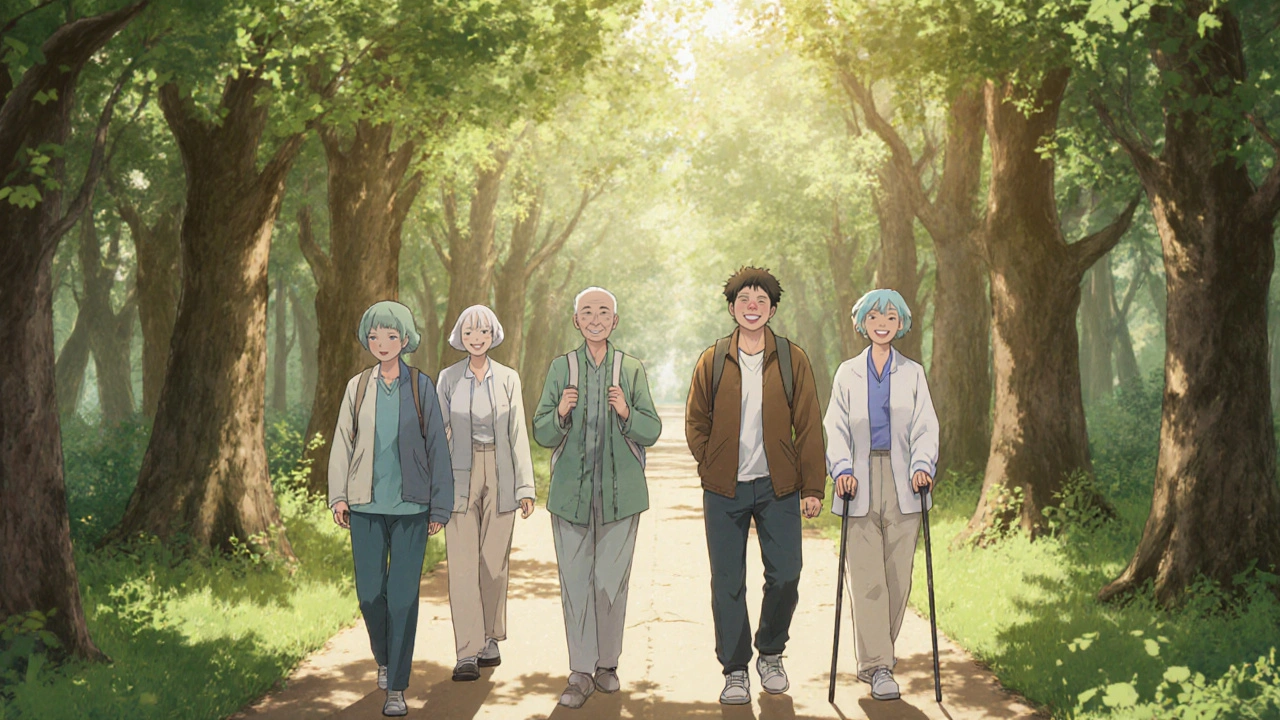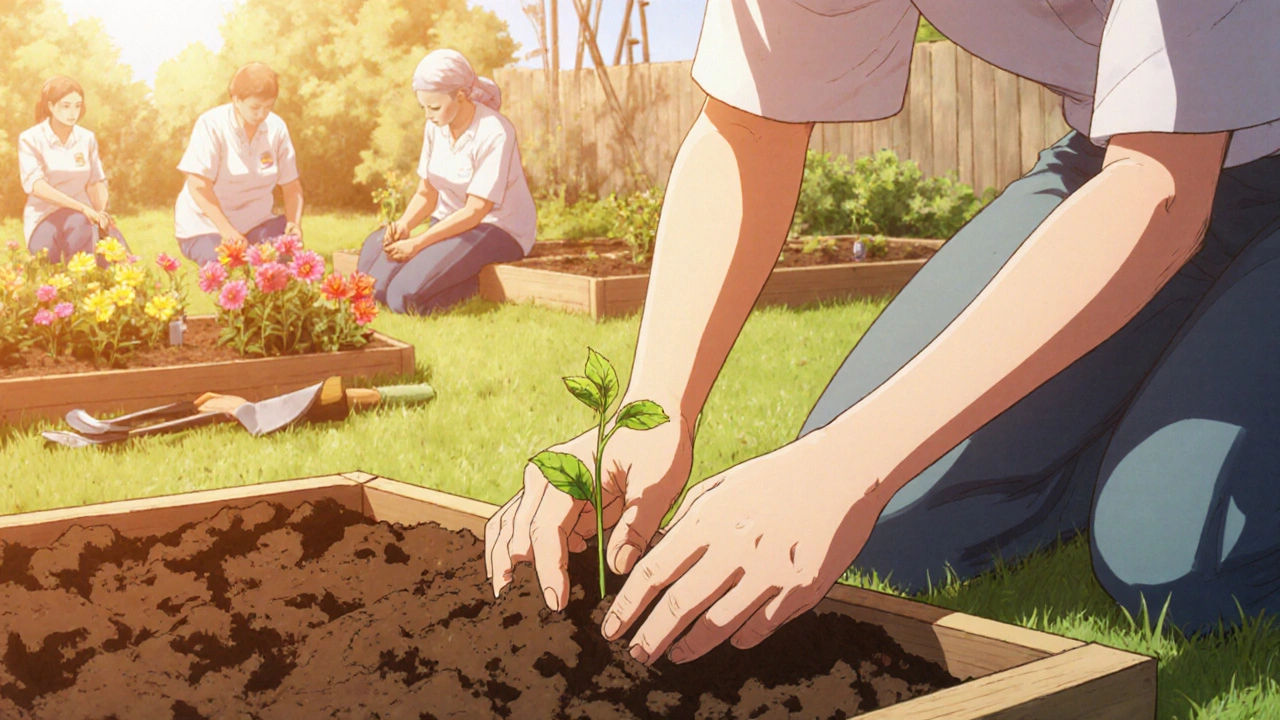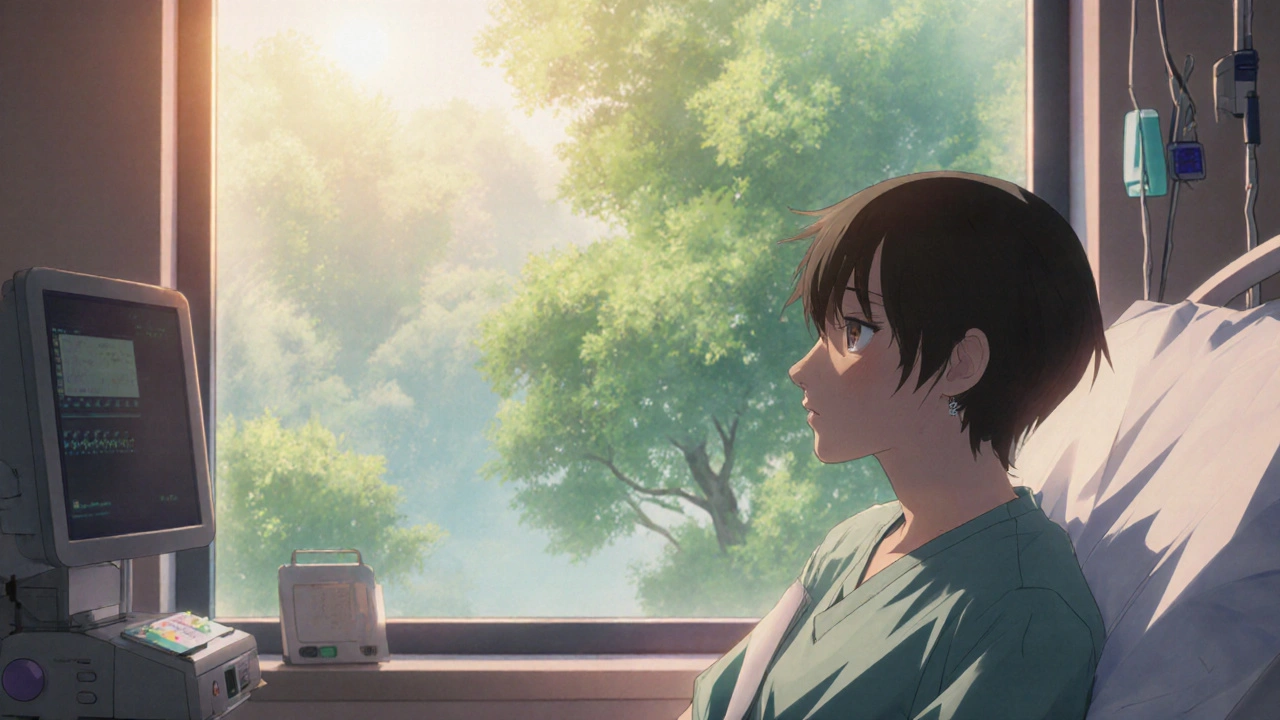Nature Therapy Session Planner
Personalize your nature therapy experience based on your current treatment status, energy levels, and health considerations. This tool helps you select safe, appropriate activities and durations for maximum benefit.
Your Therapy Plan
Your Nature Therapy Plan
Your session will help reduce stress and improve mood. Check out your personalized recommendations below.
Your recommended activity will be displayed here.
Your safety considerations will be displayed here.
When we talk about Nature Therapy is a therapeutic approach that uses natural environments-forests, gardens, parks, even indoor plants-to promote physical and mental healing. It’s not a replacement for conventional cancer treatment, but a proven complement that can ease side effects and improve wellbeing.
Key Takeaways
- Nature exposure lowers cortisol, blood pressure, and inflammation-three big stressors for cancer patients.
- Regular walks in green spaces can boost immune markers like natural killer cell activity.
- Activities such as forest bathing or gardening improve mood, sleep quality, and overall quality of life.
- Even short, daily doses of nature (10‑15 minutes) are enough to see measurable benefits.
- Safe implementation means checking with the oncology team and tailoring activities to individual energy levels.
Why Nature Matters for Cancer Care
Cancer is a disease that attacks the body’s cells and its immune system, while also causing huge emotional strain. The field of Psychoneuroimmunology studies how thoughts, emotions, and the nervous system influence immune function. Studies show that exposure to natural settings triggers a cascade of neuro‑endocrine changes that calm the nervous system, lower cortisol, and allow immune cells to work more efficiently.
For a patient undergoing chemotherapy or radiation, those physiological shifts can mean fewer infections, reduced fatigue, and a smoother recovery. In other words, nature creates a supportive backdrop that lets the body focus on healing rather than fighting stress.
Proven Benefits Backed by Research
Here are the main benefits that have been documented in peer‑reviewed journals up to 2025:
- Stress Reduction: A 2023 randomized trial of 120 breast‑cancer patients found a 30% drop in serum cortisol after 30‑minute forest walks three times a week.
- Immune Boost: Researchers at the University of Queensland measured a 12% increase in natural killer (NK) cell activity after participants spent 45 minutes in a botanical garden daily for two weeks.
- Improved Mood & Anxiety: Meta‑analysis of 15 studies (2020‑2024) reported an average 1.8‑point reduction on the Hospital Anxiety and Depression Scale (HADS) for patients engaging in garden‑based activities.
- Better Sleep: A pilot study in Japan showed that forest‑bathing (shinrin‑yoku) participants slept 45 minutes longer on average, with deeper REM cycles.
- Physical Activity without Overexertion: Gentle walking among trees boosts circulation and muscle tone while keeping heart rate in a safe range for most oncology patients.
Popular Forms of Nature Therapy
Not all nature exposure looks the same. Below is a quick guide to the most common modalities, their typical session length, and the key outcomes they target.
| Modality | Typical Session | Primary Benefits | Special Considerations |
|---|---|---|---|
| Forest Bathing (Shinrin‑yoku) | 30‑60min walk | Stress ↓, Immune ↑, Mood ↑ | Requires accessible forest trail; avoid extreme weather. |
| Gardening Therapy | 45‑90min planting/harvesting | Physical activity, Sense of purpose, VitaminD | Need sturdy tools, wheelchair‑friendly beds. |
| Horticultural Therapy (Indoor) | 15‑30min potting or caring for plants | Fine‑motor skill, Calmness, Air quality | Suitable for limited mobility or hospital rooms. |
| Animal‑Assisted Nature Walks | 20‑40min with therapy dog or rabbit | Emotional bonding, Anxiety ↓, Motivation ↑ | Check for allergies; ensure animal is certified. |

How to Get Started Safely
Before any new activity, talk with the oncology team. They can flag contraindications such as low blood counts, severe fatigue, or skin sensitivities.
- Assess Mobility: Choose a modality that matches the patient’s current stamina. For bedridden patients, even looking at a live plant or using a virtual‑reality forest can trigger similar calming pathways.
- Pick the Right Setting: Parks with smooth paths, community garden plots, or hospital green roofs are ideal. Avoid areas with heavy pollen if the patient has allergies.
- Start Small: Begin with 10‑minute sessions and gradually increase. Consistency beats intensity.
- Bring the Essentials: Hydration, sun protection, comfortable shoes, and a lightweight backpack for snacks or medication.
- Track Progress: Use a simple journal to note mood, pain levels, sleep quality, and any side effects. This data helps the care team adjust treatment plans.
Remember, the goal isn’t to replace chemo or radiation-it’s to make the overall journey smoother.
Precautions and Red Flags
Nature therapy feels harmless, but cancer patients can be vulnerable.
- Immune Suppression: If white‑blood‑cell counts are low, avoid crowded parks or soil contact that may carry pathogens.
- Sun Exposure: Many patients are photosensitive due to medication. Use sunscreen and schedule sessions in the early morning or late afternoon.
- Fatigue Management: If a session leaves the patient more exhausted than before, cut the duration in half and reassess.
- Allergies: Pollen, insect bites, or animal dander can trigger reactions. Choose hypoallergenic plants or animal‑free options.
Real‑World Success Stories
Emily, a 48‑year‑old kidney‑cancer survivor from Sydney, began a weekly gardening group at a community garden after her second round of chemo. Within six weeks she reported a 20% drop in self‑rated pain and could walk 15minutes longer each day. Her oncologist noted a stable blood‑count profile, attributing part of the resilience to the regular outdoor activity.
Another case: a group of 30 lung‑cancer patients participated in a 12‑week forest‑bathing program in the Blue Mountains. The study, published in the Australian Journal of Cancer Care, found a statistically significant improvement in the Functional Assessment of Cancer Therapy (FACT‑G) scores.

Frequently Asked Questions
Frequently Asked Questions
Can nature therapy be done during chemotherapy?
Yes, as long as the patient feels stable enough for gentle activity. Short walks or indoor plant care are usually safe. Always check blood counts and fatigue levels with the treatment team first.
Do I need a forest to benefit, or are city parks enough?
City parks, gardens, and even well‑maintained green rooftops can trigger similar physiological responses. The key is exposure to greenery, fresh air, and natural light.
How often should I practice nature therapy?
Aim for at least three sessions per week, each lasting 10‑30minutes. Consistency matters more than duration.
Is there any equipment I need?
Comfortable shoes, a water bottle, sun protection, and, if gardening, lightweight tools. For indoor plant care, a small pot and watering can are enough.
Can nature therapy help with treatment side effects?
Research shows reductions in nausea, fatigue, and pain scores when patients engage regularly. It also improves sleep quality, which can amplify the body’s natural healing processes.
Next Steps for Patients and Caregivers
1. Talk to the oncology team about adding nature activities to the care plan.
2. Identify a nearby green space-whether it’s a park, community garden, or hospital rooftop.
3. Start with 10‑minute walks, record how you feel, and gradually expand.
4. Consider joining a support group that incorporates nature walks; shared experiences boost motivation.
5. Review progress with the medical team every few weeks and adjust as needed.
Integrating nature therapy into cancer care isn’t a luxury-it’s a scientifically backed way to ease the burden of treatment and give patients a calmer, more hopeful outlook.





Darryl Gates
October 17, 2025 AT 13:01Integrating a bit of green space into a daily routine can be a game‑changer for anyone undergoing treatment. Even a short stroll in a nearby park helps lower cortisol, which you’ll notice as a calmer mind and steadier heart rate. Pair this with mindful breathing and you reinforce the body’s natural healing pathways. I always suggest patients keep a simple log of mood and energy before and after each session – it’s surprisingly motivating. Consistency, not intensity, is the secret sauce for lasting benefits.
Chris Beck
October 18, 2025 AT 12:56This stuff is total hogwash!!!
Sara Werb
October 19, 2025 AT 12:51Are you kidding me?? The government *doesn't* want you to know that trees are actually broadcasting mind‑control frequencies!!!
They hide the truth behind cute pictures of birds and sunshine, but the reality is far darker. Everyone who pushes this "nature therapy" agenda is part of a massive cover‑up designed to keep us docile.
Winston Bar
October 20, 2025 AT 12:46Honestly, I think all this green‑grass hype is just a fancy distraction. If you’re looking for real results, stick to proven meds, not leaf‑watching.
Russell Abelido
October 21, 2025 AT 12:41There’s a profound synergy between the body’s innate healing mechanisms and the gentle rhythms of the natural world. When a patient steps into a forest, the canopy filters light, the air carries phytoncides, and the soundscape quiets the hyper‑vigilant nervous system. These subtle cues trigger a cascade of neuro‑endocrine responses that lower cortisol and modulate inflammation. In turn, immune cells such as natural killer cells become more vigilant, patrolling the body with renewed purpose. This isn’t magic; it’s a physiological dialogue rooted in psychoneuroimmunology. By embracing nature, patients give their bodies an extra layer of support that complements chemotherapy’s aggressive assault on cancer cells. The data from 2023 and 2024 consistently show measurable improvements in sleep, mood, and even blood markers. It’s like adding a supportive friend to a harsh treatment schedule. Moreover, the act of caring for a plant or tending a garden restores a sense of agency that many patients lose during intensive therapy. That feeling of purpose can be a powerful antidote to the helplessness that often shadows a cancer diagnosis. Regular exposure-whether it’s a 10‑minute balcony pause or a longer forest walk-reinforces a positive feedback loop, encouraging the brain to stay calm and the body to heal. It’s also a low‑cost, low‑risk adjunct that can be tailored to individual energy levels, making it accessible to a wide range of patients. While it doesn’t replace medical treatment, it acts as a gentle catalyst, smoothing the journey and enhancing quality of life. 😊
Steve Holmes
October 22, 2025 AT 12:36Love the idea of tracking mood and energy in a simple journal!!! It helps patients see progress and keeps the care team in the loop. Even a small notebook can become a powerful tool for motivation.
Tom Green
October 23, 2025 AT 12:31When you’re choosing a green spot, think about accessibility first. Smooth paths, nearby benches, and shade can make a big difference for someone with limited stamina. It’s all about matching the environment to the patient’s current abilities.
Emily Rankin
October 24, 2025 AT 12:26Imagine each leaf as a tiny beacon of hope, whispering encouragement to a weary soul. By stepping into that whisper, patients tap into an ancient reservoir of resilience. The mind begins to heal alongside the body, and suddenly the road ahead feels less daunting. It’s a beautiful reminder that even in the toughest battles, there’s room for light and growth. 🌿
Rebecca Mitchell
October 25, 2025 AT 12:21Not all parks are great for chemo patients
Roberta Makaravage
October 26, 2025 AT 11:16Actually, there are specific guidelines for safe outdoor exposure, and they’re backed by clinical trials. 🌱📚 It’s not just a feeling; it’s evidence‑based practice that can enhance quality of life.
Lauren Sproule
October 27, 2025 AT 11:11i think it really helps many ppl its nice to see support from community and green spaces. keep it simple and kind.
CHIRAG AGARWAL
October 28, 2025 AT 11:06yeah but don’t overdo it or you’ll waste time you could spend on meds
Patricia Echegaray
October 29, 2025 AT 11:01The elites don’t want you strolling in the woods because they fear the awakening of a collective consciousness that could topple their corrosive agenda. Yet, those verdant pathways offer a sanctuary where truth can bloom, unshackled from the neon‑lit propaganda of the mainstream. Embrace the wild, for it is a rebellious act of sovereignty.